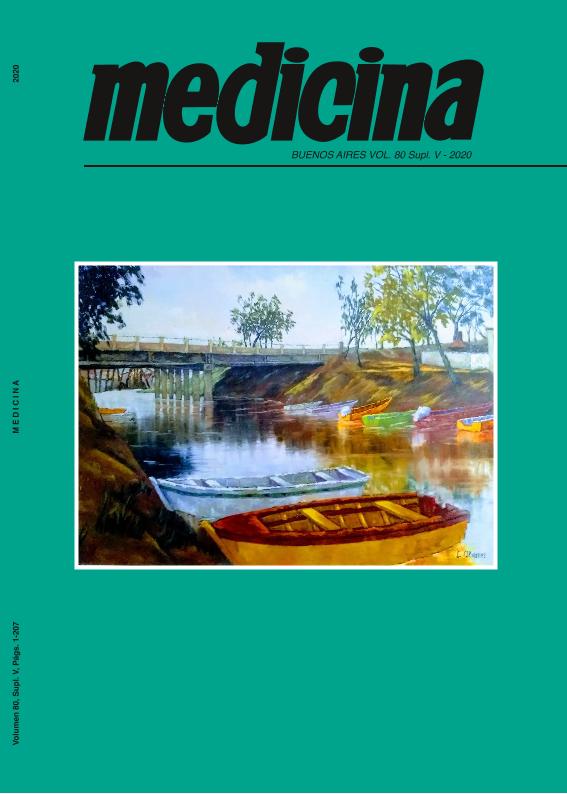Evento
Eliglustat as a possible strategy to prevent the detrimental effects of Shiga toxin type 2: Preliminary results in vivo
Gomez, Fernando Daniel ; Sacerdoti, Flavia
; Sacerdoti, Flavia ; Toytoyndjian, Eugenia Victoria; Ibarra, Cristina Adriana
; Toytoyndjian, Eugenia Victoria; Ibarra, Cristina Adriana ; Amaral, María Marta
; Amaral, María Marta
 ; Sacerdoti, Flavia
; Sacerdoti, Flavia ; Toytoyndjian, Eugenia Victoria; Ibarra, Cristina Adriana
; Toytoyndjian, Eugenia Victoria; Ibarra, Cristina Adriana ; Amaral, María Marta
; Amaral, María Marta
Tipo del evento:
Reunión
Nombre del evento:
LXV Reunión Anual de la Sociedad Argentina de Investigación Clínica; LXVIII Reunión Anual de la Sociedad Argentina de Inmunología y LIII Reunión Anual de la Asociación Argentina de Fisiología
Fecha del evento:
10/11/2020
Institución Organizadora:
Sociedad Argentina de Investigación Clínica;
Sociedad Argentina de Inmunología;
Asociación Argentina de Fisiología;
Título de la revista:
Medicina (Buenos Aires)
Editorial:
Fundación Revista Medicina
ISSN:
0025-7680
Idioma:
Inglés
Clasificación temática:
Resumen
Typical HemolyticUremic Syndrome (HUS) is a complication of Shiga toxin (Stx)-producingEscherichia coli (STEC) infection and the most frequent cause of acute renalfailure in children in Argentina. Stx2 binds to globotriaosylceramide (Gb3)receptor and causes direct damage on human renal microvascular endothelialcells (HGEC). Previously, we found that Eliglustat (EG), a Gb3 synthesisinhibitor, prevents the cytotoxic effects of Stx2 on HGEC. In this work, we evaluatedthe action of EG against the effects of Stx2 in vivo. Male BALB/c mice atweaning (17-21 days) received 3 doses of EG (0.6 mg/g body weight (bwt)administered intraperitoneally (i.p.) every 24 h. After a rest period of 5days, mice were i.p. injected with a lethal (1ng/g bwt) or sublethal (0.1 ng/gbwt) dose of Stx2 (EG+Stx2) or PBS (EG). Two additional groups of mice withoutEG pre-treatment were injected one with PBS (Ctrl) and another with Stx2(Stx2). Survival, body weight (Δ weight= body weight after Stx2 or PBS injection-bodyweight at a day before injection) and food intake were registered daily. EG didnot affect body weight gain (Δ weight: EG: 0.61 ± 0.07 g vs. Ctrl: 0.76 ± 0.09g; n=3, ns). After Stx2 lethal dose treatment, EG+Stx2 mice showed a bodyweight decrease and a survival time (48-72 h) similar to Stx2 mice. On thecontrary, after 3 days of Stx2 sublethal dose injection, while Stx2 miceexhibited piloerection and inactivity and body weight loss, EG+Stx2 mice did notshow signs of illness and gained weight (Δ weight: EG+Stx2: 0.81 ± 0.09 vs.Stx2: -0.65 ± 0.05 g; n=3, p<0.05). Body weight loss in Stx2 mice wasassociated with a significant decrease (70%) in food intake, unlike EGpre-treated mice that reduced intake by only 15% (n=3, p<0.05). Theseresults suggest that EG may reduce the disease symptoms caused by Stx2, such aspoor appetite and the resulting body weight loss. Future studies will analyzeif EG prevents the renal damage and will improve EG treatment to avoidmortality.
Palabras clave:
eliglustat
,
shiga toxin
,
mice
Archivos asociados
Licencia
Identificadores
Colecciones
Eventos(IFIBIO HOUSSAY)
Eventos de INSTITUTO DE FISIOLOGIA Y BIOFISICA BERNARDO HOUSSAY
Eventos de INSTITUTO DE FISIOLOGIA Y BIOFISICA BERNARDO HOUSSAY
Citación
Eliglustat as a possible strategy to prevent the detrimental effects of Shiga toxin type 2: Preliminary results in vivo; LXV Reunión Anual de la Sociedad Argentina de Investigación Clínica; LXVIII Reunión Anual de la Sociedad Argentina de Inmunología y LIII Reunión Anual de la Asociación Argentina de Fisiología; Argentina; 2020; 84-84
Compartir



